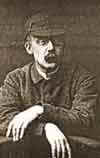|
Emile
FRECHON Photographe
de l'Ecole Naturaliste,
Actif de la fin du XIXème au début du XXème siècle
Né à Blangy-sur- Bresle en Seine Maritime. Il est l'aîné d'une famille
de sept enfants dont Charles FRECHON ( 1856-1929 ) peintre de renom de
l'Ecole de ROUEN.Emile FRECHON est un artiste et un lettré reconnu à son
époque.
En 1893, les épreuves qu'il envoie à l'exposition annuelle de la Photographic
Society of Great Britain lui valent la reconnaissance des photographes
P. H. EMERSON et de F.M. SUTCLIFFE, qui lui accordent une
médaille d'or, tandis que les critiques anglais soulignent la qualité
technique de ses "collotype printing on rough paper".
Le photographe participe à la première et à la deuxième Exposition d'Art
Photographique du photo-club de Paris (1894-1895 ).
En 1904, "La Revue de Photographie" le considère comme le "
Millet de la photographie". Le mensuel du Photo-Club de Paris publiera,
de 1903 à 1908, 39 illustrations des oeuvres de Fréchon ce qui le place
juste dérrière Demachy.
Son style, intact depuis plus de dix ans, est mis en avant ; il correspond
en effet davantage aux recherches qui, dans les dix premières années du
siècle, tentent de faire sortir le pictorialisme français de son académisme
Il partage sa vie sur deux continents, l'hiver en Algérie à BISKRA où
il a ouvert un atelier de photographie vers 1895 et les autres saisons
dans le nord de la FRANCE, en particulier à ETAPLES dans le Pas-de-Calais
et en ANGLETERRE.
Parmi les nombreuses publications photographiques de l'époque qui s'intéressent
à son travail, "L'Algérie artistique et pittoresque" parue de
1890 à 1894, publie en 1892 un numéro consacré à BISKRA dont les textes
et les 47 photographies sont de Emile FRECHON.
Après sa mort en 1921, ses photographies seront publiées jusque dans les
années 30 en particulier à l'occasion du centenaire de l'Algérie.
Emile
FRECHON Photographer
of the Naturalistic School
Active from the end of the XIXth century until the beginning of the XXth
century.
He was born in France. He was the eldest brother of a family of seven
children. Amongst these, was Charles FRECHON ( 1856-1929 ) a well-known
painter from the ROUEN School.
In his own time already, Emile FRECHON was considered both a famous artist
and a well-read person.
In 1893, he sent some of his photographies to the yearly exhibition of
the Photographic Society of Great Britain. Both the photographers P.H.
EMERSON and F.M. SUTCLIFFE noticed his talent. He was granted with a golden
medal, and the english critics emphasized upon the technical quality of
his
"collotype printing on rough paper".
The photographer took part in both the first and the second of the exhibitions
organized by the Paris photo-club ( Exposition d'Art Photographique du
photo-club de Paris 1894-1895 ).
In 1904, " La Revue de Photographie" considered him to be the
Millet of Photography. Also, the Paris Photo-Club's monthly magazine published
39 of Fréchon's works between 1903 and 1908 placing him second after Demachy.
It also underlines his style, unchanged for over ten years : This style
indeed is characterized on the turn of the twentieth century by the fact
that he tried to pull french pictorialism out of its academism.
He spent his life alternating between two continents. Indeed it was in
Algeria, at BISKRA, where he opened a photography workshop around 1895
that he spent winter. Whereas it is in the north of France and in England
that he stayed during the other seasons.
"L'Algérie artistique et pittoresque" one of the numerous photography
publications which was printed between 1890 and 1894 took an interest
in his work. It published an issue dedicated to BISKRA in which its texts
and 47 photographies were Emile FRECHON's.
Even after his death in 1921, his photographies still are published up
until the thirties and particularly for Algeria's centenary.
|

